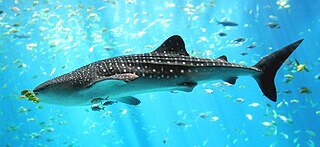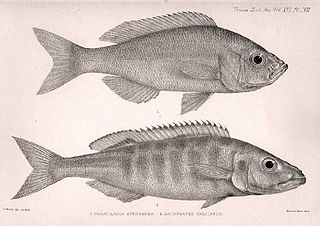
The Scorpaeniformes are a diverse order of ray-finned fish, including the well-known lionfish, but have also been called the Scleroparei. It is one of the five largest orders of bony fishes by number of species with over 1,320.

Mahseer is the common name used for the genera Tor, Neolissochilus, and Naziritor in the family Cyprinidae (carps). The name is, however, more often restricted to members of the genus Tor. The range of these fish is from Malaysia, Indonesia, and across southern Asia including the Indian Peninsula and Pakistan. They are commercially important game fish, as well as highly esteemed food fish. Mahseer fetch high market price, and are potential candidate species for aquaculture. Several of the larger species have suffered severe declines, and are now considered threatened due to pollution, habitat loss, and overfishing.

The Lamniformes are an order of sharks commonly known as mackerel sharks. It includes some of the most familiar species of sharks, such as the great white and extinct megalodon, as well as more unusual representatives, such as the goblin shark and megamouth shark.

Carpet sharks are sharks classified in the order Orectolobiformes. Sometimes the common name "carpet shark" is used interchangeably with "wobbegong", which is the common name of sharks in the family Orectolobidae. Carpet sharks have five gill slits, two spineless dorsal fins, and a small mouth that does not extend past the eyes. Many species have barbels.

The Synodontidae or lizardfishes are benthic (bottom-dwelling) marine and estuarine bony fishes that belong to the aulopiform fish order, a diverse group of marine ray-finned fish consisting of some 15 extant and several prehistoric families. They are found in tropical and subtropical marine waters throughout the world.

The duckbill eels or witch eels are a family, Nettastomatidae, of eels. The name is from Greek netta meaning "duck" and stoma meaning "mouth".

The shortspine spurdog is a dogfish, a member of the family Squalidae, found on continental shelves off Japan in temperate waters, from the surface to 950 m. Its length is up to 75 cm.

Hemibates stenosoma is a species of cichlid endemic to Lake Tanganyika in East Africa. It is generally most numerous at depths between 80 and 200 m (260–660 ft), but performs a seasonal migration to inshore regions when it can occur as shallow as 20 m (65 ft). It is predatory, feeding on fish and prawns, and grows to a total length of 30 cm (1 ft). This species was formerly regarded as the only formally described member of its genus., however, another species, Hemibates koningsi, which was formerly referred to as referred to as Hemibates sp. "stenosoma chituta" before its formal description.

Garra is a genus of fish in the family Cyprinidae. These fish are one example of the "log suckers", sucker-mouthed barbs and other cyprinids commonly kept in aquaria to keep down algae. The doctor fish of Anatolia and the Middle East belongs in this genus. The majority of the more than 140 species of garras are native to Asia, but about one-fifth of the species are from Africa.

Aetobatus is a genus of eagle rays native to the Atlantic, Pacific and Indian Oceans. It was formerly placed in Myliobatidae, but is now placed in its own family based on salient differences from myliobatids, especially the pectoral fins joining the head at the level of the eyes.

Redigobius is a genus of fish in the goby family, Gobiidae, known commonly as dualspot gobies. They are native to the western Indo-Pacific region, where they occur in estuaries and freshwater habitats just above the tidal influence.

The Aulopidae are a small family of aulopiform fish. They are found in most tropical and subtropical oceans, and are commonly known as flagfins.

Pristiophorus is a genus of sawsharks found in the Pacific, Atlantic and Indian oceans. Members of this genus differ from the Sixgill Sawshark (Pliotrema warreni) in having five gill slits. Their rostral sawteeth lack prominent transverse ridges on the basal ledges, and the large teeth are not posteriorly serrated.

The Catostomidae are the suckers of the order Cypriniformes, with about 78 species in this family of freshwater fishes. The Catostomidae are primarily native to North America, but Catostomus catostomus is found in both North America and Russia, and Myxocyprinus asiaticus is from China. In the Ozarks they are a common food fish and a festival is held each year to celebrate them.
Chalaroderma is a genus of combtooth blennies found in the southeast Atlantic ocean.

Caesioperca is a genus of ray-finned fish in the sub-family Anthiadinae in the sea bass family Serranidae. It contains just two species, found in the ocean off Southern Australia and New Zealand.

Drombus is a genus of gobies native to fresh, brackish and marine waters of the Indian Ocean and the western Pacific Ocean.

Ivanacara are a genus of cichlid fishes from tropical South America. This genus was identified as a new in 2006, but many authorities do not recognize it and maintain its species in Nannacara.




















